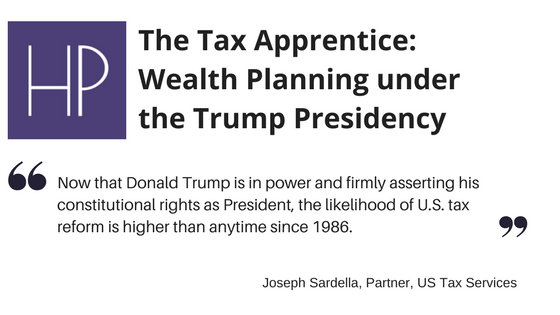The Tax Apprentice: Wealth Planning under the Trump Presidency
Now that Donald Trump is in power and firmly asserting his constitutional rights as President, the likelihood of U.S. tax reform is higher than anytime since 1986. The Republicans have their eyes set on repealing Obamacare and its maligned offspring, the 3.8% surtax on investment income, as well as possibly eliminating U.S. estate tax entirely. These potential changes have been met with approval by American resident voters, but the changes fall short in benefiting Americans living in Canada and, in particular, those who have a non-American spouse (“mixed marriage”). In this article, we will review the more pervasive U.S. tax rules that stymie well-intended Canadian tax policy and dismantle otherwise effective wealth accumulation tax planning strategies.
The Canadian Tax Free Savings Account (TFSA) has become a Canadian cornerstone of wealth planning. However, the TFSA’s benefits of tax free income accumulation and withdrawals are not entirely available to Americans living in Canada. For U.S. tax purposes, a TFSA is considered a regular investment account and the income earned is taxable on the U.S. tax return. Since Canada does not impose a tax on TFSA income, there is no Canadian tax to claim as a foreign tax credit on the U.S. tax return, thereby likely resulting in U.S. tax payable. Furthermore, the prevailing view is a TFSA is considered a foreign trust for U.S. tax purposes, which requires the filing of U.S. trust returns. Failing to file the required trust returns can result in a penalty of either $10,000 or 5% to 35% of the value of the assets held by the TFSA. To complicate the matter further, TFSAs that hold investments in Canadian mutual funds are subject to the U.S. Passive Foreign Investment Company (PFIC) rules. PFIC rules (discussed below) can result in double taxation and require taxpayers to file additional tax reporting forms, again with penalties of $10,000 for failure to comply. For these reasons, U.S. persons reluctantly dismiss TFSAs as part of their investment portfolio.
Registered Education Savings Plans (RESP) face similar hurdles. The IRS also considers RESPs to be foreign trusts, and the U.S. subscriber is considered the owner of the RESP assets and taxed annually on the income earned. Like TFSAs, foreign trust forms must also be filed for RESPs. In these situations, we recommend that the non-U.S. spouse subscribe and make the contributions to the children’s RESPs.
Canadian mutual funds take the legal form of a trust. However, the IRS takes a different position in that a Canadian mutual fund is considered a corporation. As a corporation, for U.S. tax purposes, the mutual fund is considered to be a PFIC. A corporation is a PFIC to a U.S. person if the corporation meets either an income test or an asset test. The income test is met if 75% or more of the corporation’s income is passive (e.g. dividends, interest capital gains). The asset test is met if 50% or more of the corporation’s assets are held to produce passive income. There is no minimum shareholding requirement within the PFIC rules. Holding Canadian mutual funds is a difficult challenge for Americans. The easiest strategy is to avoid them entirely or enlist the assistance of a qualified tax accountant to help navigate the tax labyrinth of rules.
The principal residence often represents the largest asset value in a Canadian family’s asset portfolio. Both the U.S. and Canada have exemptions for gains realized on the sale of a principal residence. However, while the Canadian exemption is unlimited, the U.S. exemption is limited to only the first USD $250,000 per home per person every two years. To illustrate the dilemma, assume that a mixed marriage couple jointly purchased a home in Oakville at a cost of USD $500,000 and have an offer to sell their home for USD $1,900,000. The gain on the sale is $1,400,000 which, under Canadian tax law, is totally exempt from taxation. Under the U.S. rules, tax of $107,100 would be payable by the American spouse on their U.S. tax return[1].
In the aforementioned situation, one option is to have the American spouse gift a portion of the value of the home to the non-U.S. spouse on an annual basis using the marital exemption of USD $149,000 per year. The ability to gift is very important as it relates to the principal residence. Under a carefully crafted gifting regime, a U.S. person can gift up to USD $745,000 of assets in 5 years and eliminate tax exposure on their portion of the gain.
Under the U.S. unlimited marital deduction rule, legally married U.S. citizens may pass property to their surviving U.S. citizen spouses without the imposition of U.S. estate tax as long as the property passes directly to the surviving U.S. spouse. The Canadian tax rules have a similar concept. For U.S. tax purposes, the unlimited marital deduction is not available when property passes to a surviving spouse who is not a U.S. citizen. Consider the situation where upon the death of the first spouse – the US spouse – the Canadian tax rules do not impose any income tax, yet the U.S. tax rules do not permit a similar tax deferral under the estate tax provisions. In these cases, the property would have to pass through a qualified domestic trust (QDOT) for U.S. tax purposes to achieve tax symmetry. Where the property is held by a QDOT, the U.S. estate tax is deferred until the capital is distributed from the trust or the surviving non–U.S. spouse dies. The QDOT rules are extremely onerous because at least one trustee must be a U.S. citizen; there are restrictions on trust distributions, and proper tax elections must be filed. Typically the QDOT is mentioned in the will.
Should the Republicans be successful in eliminating estate tax, it will most likely be replaced with a tax regime similar to the Canadian tax rules. In this regard, the U.S. death tax will change from a tax on the gross value of a U.S. person’s worldwide estate to an income tax on the appreciated capital gain on assets held at death. However, the lack of symmetry between the Canadian and U.S. tax rules will not be solved. For example, upon the death of the U.S. spouse, there will be immediate gain recognition and U.S. tax will be imposed. The after-taxed property will pass to the non-American spouse. For Canadian tax, there is a ‘spousal rollover” so that Canadian tax is deferred until there is a sale of the inherited property or until the death of the surviving spouse. As a result, capital gains tax will be paid twice on the same gain. Although the Canadian executor can elect out of the rollover for Canadian tax purposes to achieve a matching of tax credits, the tax deferral will be lost. It is not clear whether the U.S. will renegotiate the tax treaty provisions to address this issue.
Jean-Baptiste Colbert, Louis XIV’s finance minister, once said “the art of taxation consists in so plucking the goose as to obtain the largest possible amount of feathers with the smallest possible amount of hissing.” The operation of the U.S. tax rules above overreach this maxim. Americans in Canada are frustrated in their inability to undertake effective wealth planning in their home country. Advocacy groups complain but the IRS is not listening. Their situation brings to mind the phrase generally attributed to James Otis in 1761 of “no taxation without representation.” It would serve the US government well to consider the impact of these U.S. tax rules on Americans living abroad.
Interested in learning how we can help you manage your US assets? Contact us!
Joseph Sardella is our U.S. tax partner with over twenty-five years of practical tax experience in U.S. and cross border tax matters. He was admitted to partnership in 2014.
[1] One half of the gain or $700,000 would be attributed to the US spouse. Since $250,000 is the exemption amount, $450,000 represents the taxable portion of the gain. Using a tax rate of 23.8% on the gain would result in US tax owing of $107,100.

